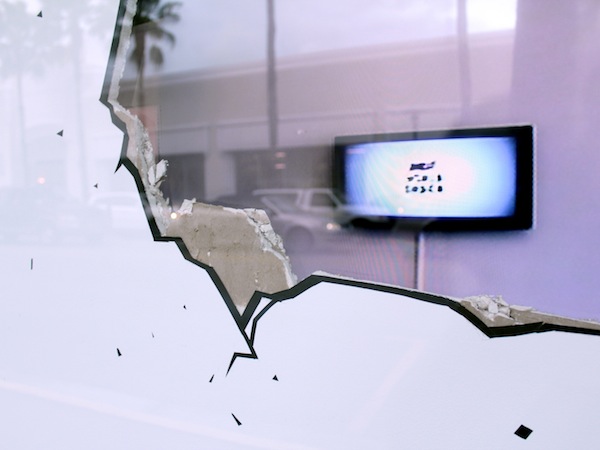
Juan López, Between Walls at ArtCenter/South Florida
By Elizabeth Shannon. Knight Curatorial Fellow Bass Museum of Art
The ArtCenter/South Florida’s Richard Shack Gallery has been looking rather unusual for the last few months. For visitors (such as myself) who had not been into the gallery space before, it took a few moments to realize that something strange was going on. Upon entering, visitors were faced with a white, sculptural-looking wall, which extended from floor to ceiling (as walls often do). Upon closer inspection, the structure seemed a little odd. Rather than meet the ground straight on in the usual way, the wall seemed ‘folded’ onto the floor. Furthermore, the surface of the wall-like structure also appeared to include several ‘folds’. Finally, there was the unusual location of the air vent, which was positioned vertically rather than in the more common horizontal configuration. And what was that hole doing in the black section of wall above?
Juan López, Dry the Wall (2013), wood, drywall, tape, 4 monitors and 4 cameras. Presented as part of tc: temporary contemporary. Photographs by Juan López. Courtesy of ArtCenter/South Florida
After an understandable double-take, all began to become clear. By covering the wall above the gallery’s front windows with black vinyl and building the white ‘folded’ structure, the wall appeared to have been peeled back and folded down onto the floor, as though it were a giant sheet of paper. Such wry interventions are characteristic of López’s work, as is his engagement with architecture and the urban environment. By playing with space, and also with words, López challenges the viewer’s perception of their surroundings.
A Spaniard currently based in Madrid, López is the first of a number of visiting artists from outside of the United States to undertake a residency with the ArtCenter in 2014 to celebrate their 30th anniversary. Several of the exhibited works, including the previously discussed (f)old down (2013), were directly influenced by López’s observations of Miami Beach. The Logic – The Moment (2013) is another piece which exhibits López’s growing familiarity with the local area. The piece consists of a quote taken from the celebrated art critic and theorist Rosalind Krauss’s essay ‘Sculpture in the Expanded Field’. The quote reads: “The logic of sculpture is inseparable from the logic of the monument”. Using video projection, López illuminates various configurations of letters to form different messages (much as you get when part of a neon sign burns out), playing with the sense of Krauss’s original assertion, and suggesting a wider, and sometimes contradictory, range of ideas. Whether familiar with the argument of Krauss’s essay or not, habitués of Lincoln Road would have picked up on a further twist presented by the work – each individual letter form was taken from the sign of a local store, enabling us to recognize an ‘s’ from ‘Sketchers’ signage here, and an ‘ä’ from the ‘Hofbräu Beer Hall’ there.
The work that probably received the most attention (although not all viewers may have registered it) was Dry the Wall (2013), presented in the gallery’s large glass-plate windows facing onto Meridian Road, which normally afford a view into the gallery. López shut down this possibility by covering over the windows. Instead, passersby could see what was going on in the gallery via four monitors positioned in holes in the drywall. The apparent violence required to make each hole was reinforced by López’s use of vinyl tape to create the impression of a heavily cracked surface. From inside the gallery, viewers could only see a white wall punctuated by four black dome-shaped CCTV cameras.
Public art is often discussed in terms of its ability to ‘disrupt’ a space and cause the public to look again at a familiar environment; this work in particular may well have achieved this aim. However, Dry the Wall also communicates a further intent. There is something willfully perverse about blocking up the mechanism through which a space can normally be clearly seen, and replacing it with screens that allow the viewer only part of the visual access that the original window afforded. Similarly, viewing through cameras and a screen, rather than a window, creates a strange sense of dislocation. It is also significant that López chose to utilize a method of surveillance that is in increasingly common usage in urban areas. This piece promotes careful thought about the recording of our movements in public spaces, while the exhibition as a whole encourages visitors to reacquaint themselves with the actuality of their surroundings through López’s particular form of “poetic resistance”.
Recent Content
-
Artsarticle ·
-
Artsarticle ·
-
Artsarticle ·

